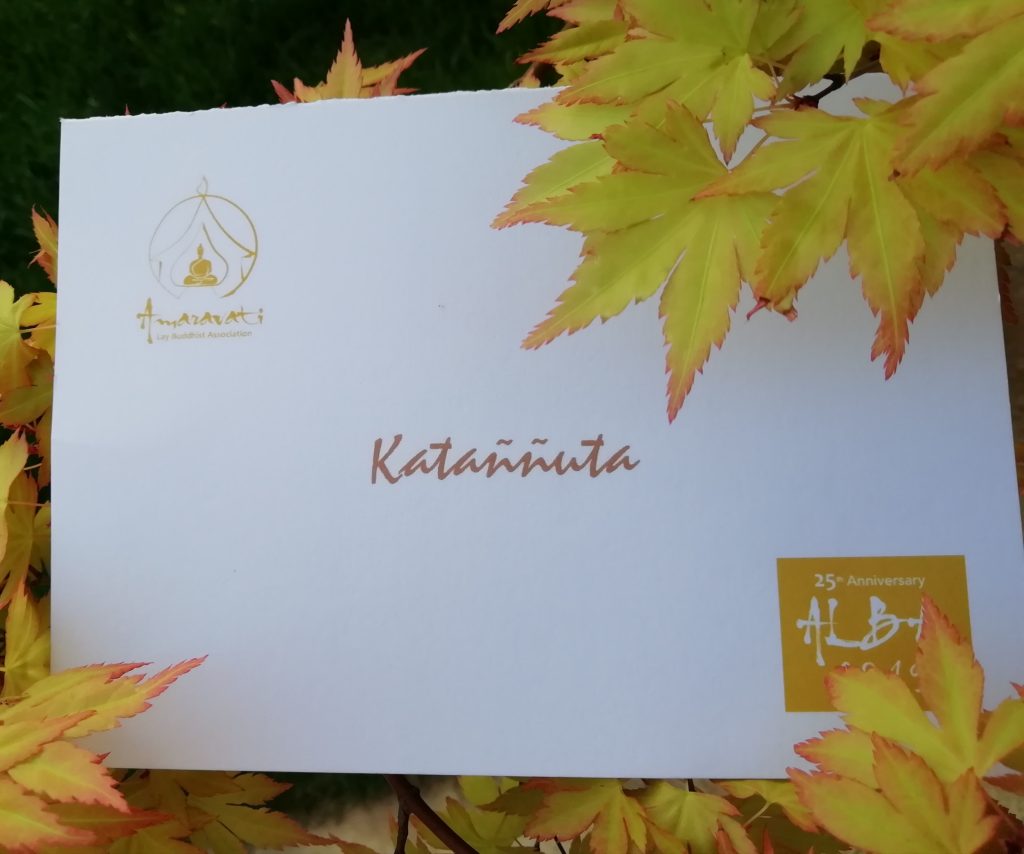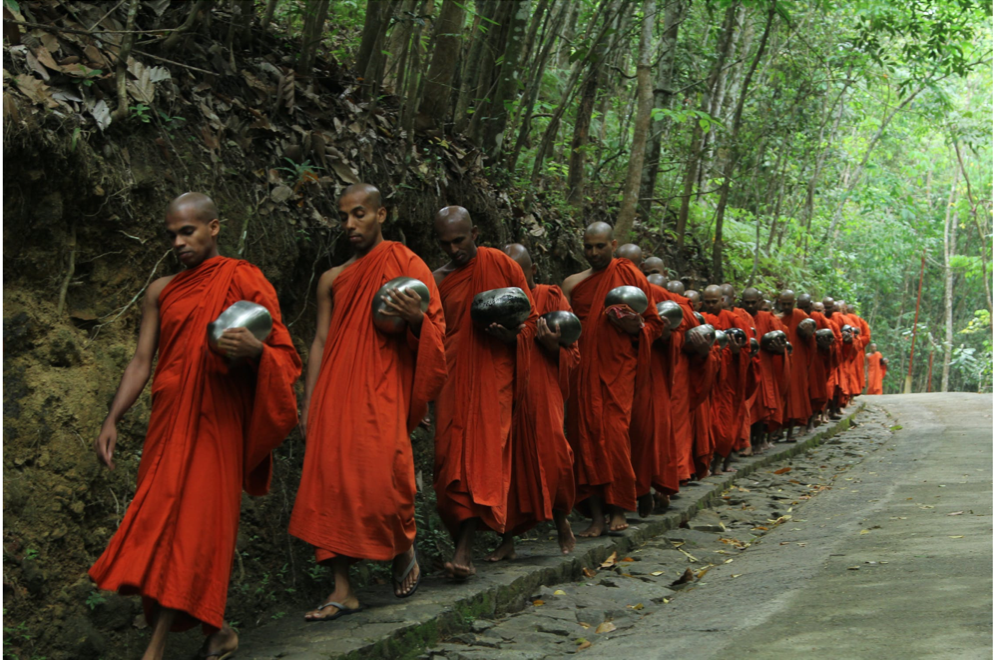
Gratitude
To quote Ajahn Sumedho,
‘A life without gratitude is a joyless life. If life is just a continuous complaint about the injustices and unfairness we have received and we don’t remember anything good ever done to us, we fall into depression—not an uncommon problem these days. It is impossible to imagine ever being happy again: we think this misery is forever.’ 1
This is quite a timely reflection for us to sit with and contemplate, bring to mind those beings that we are grateful for in these times when we may feel that life is just not fair.
Rare persons in the world
The Buddha held gratitude in such high esteem that he considered those who are grateful as rare as the appearance of a Buddha and the Dhamma in this world.
‘?The appearance of three persons is rare in the world. Which three?
The appearance of a Buddha, …
The appearance of a person who can teach the Dhamma and Vinaya proclaimed by the Buddha, …
And the appearance of a person who is grateful (kataññu) and helps in return (katavedi), is rare in the world.’?
– (AN 3:114) 2,3
?‘There are two persons who are rare to find in the world. Which two?
First, the one who volunteers to help others selflessly (pubbakari).
And second, the one who is grateful and thankful for the kindness done (kataññu)’
– (AN 2:119) 3,4
Gratitude in the teachings
In the Dhamma teachings gratitude is referred to as Kuttaññu – katavedi. There are two aspects to gratitude one is acknowledging and being grateful and the second is acting upon this feeling. So, Kataññuta is knowing or acknowledging the benefits received from another’s kindness and the feeling of gratittude. Katavedi is expressing this in return through words and actions. 3,5
Gratitude to the teachings
We know that the gift of Dhamma excels all gifts as it truly relieves beings of suffering, it is not a temporary release from suffering that we may gain from worldly means. If one lives and acts according to the Dhamma then one is on the Path to complete release from all suffering. So to receive this wonderful gift, we must be truly grateful to the monastic community and the monastery.

So what instruction has the Buddha given us in how we could show gratitude to the Monastic community? We refer to Siglaovada Sutta (DN31) – a discourse to Sigalaka, a lay Dhamma practitioner on guidelines for household life. In this discourse the Buddha outlines the types of relationships we may encounter and gives us some guidance on our roles and responsibilities within each. In the context of our relationship with ascetics the Buddha advises us that our responsibility is five-fold,
- Kindly actions
- Kindly speech
- Kindly thoughts
- Having an open door
- Providing material needs 6
In other words points 1 to 3 would fall under Sila (virtue) and points 4 and 5 under Dana (generosity).

Dana
Reflecting on Dana, it is integral to our practice – though often considered as ‘beginner’s or elementary’ practice. It is part of the three pillars of Dana(generosity), Sila (virtue), Bhavana (mental cultivation). All three of these aspects need to be perfected for the heart to awaken and see clearly. Perfecting just one aspect would be like having a stool with one leg – it cannot stand up. Perfecting just two will be like a stool with two legs it is still not stable but a stool that has three legs can stay upright, awake and bear the weight of the world.
As Ajahn Lee says,
‘As a first step we’re taught dana — to be generous, to give donations — as a strategy for getting us to learn how to let go.
The next step is caga — renouncing rights of possession — which is letting go at a higher level than dana.
And finally, on a more refined level, we’re taught to relinquish all our upadhi, or the acquisition-defilements in the mind.
This is the level on which we examine and explore until we can gain total release.’ 7
So, gratitude and Dana often though sidelined in our Dhamma practice and discussions as elementary or not so profound, I would encourage you to look at it, contemplate it and integrate this in to your lives. Actively bringing to mind those who have helped you and helping them in return. Recollecting that The Path is a gradual descent to the ocean of understanding. We cannot jump in to the deep ocean and expect to swim. It requires a training in and perfecting of Dana, Sila and Bhavana. All three aspects are of equal importance, like each leg is for the stool to stay upright.
‘The Buddha said to be born as a human being is difficult but having been born to bring one’s human life to perfection is even more difficult’
– Ajahn Chah
When each strand is strengthened and reaches maturity then and only then is the heart ready and fully awake to see things clearly, for wisdom to arise, to gain release from all suffering.
For ultimately, it is but the greatest dana of all, relinquishing our own sense of self that frees us – leads us to true freedom from this cycle of suffering.
We remain grateful to those who have shown us these Teachings.
With Metta
Randula
12 April 2020
| References 1. Ajahn Sumedho (2006) Gift Of Gratitude. Buddhist Review. Tricycle [Online] Available at https://tricycle.org/magazine/gift-gratitude-2/ 2. Anguttara-nikàya Book of Threes. Rare. (AN 3:114) [Online] Available at https://suttacentral.net/an3.114/en/sujato 3. Wijesinghe M under guidance of Venerable Nyanadassana Thero. (2008) Gratitude in The Buddhist’s Teaching. Sri Lanka. [Online] Available at https://www.dhammatalks.net/Books8/Bhikkhu_Nyanadassana_n_Mahinda-Gratitude.pdf 4. Anguttara-nikàya Book of Twos. Hard to Find.(AN 2:119) [Online] Available at https://suttacentral.net/an2.118-129/en/thanissaro 5. Pali Text Society, London. The Pali Text Society’s Pali-English dictionary. Chipstead, 1921-1925. [Online] Available at https://dsalsrv04.uchicago.edu/dictionaries/pali/ 6. Diga-nikàya (The Long Discourses) Sigalovada Sutta (DN31) [Online] Available at https://www.accesstoinsight.org/tipitaka/dn/dn.31.0.ksw0.html 7. Ajahn Lee (1953) Letting go: Notes from a talk [Online] Available at: https://www.accesstoinsight.org/lib/thai/lee/startsmall.html#small |